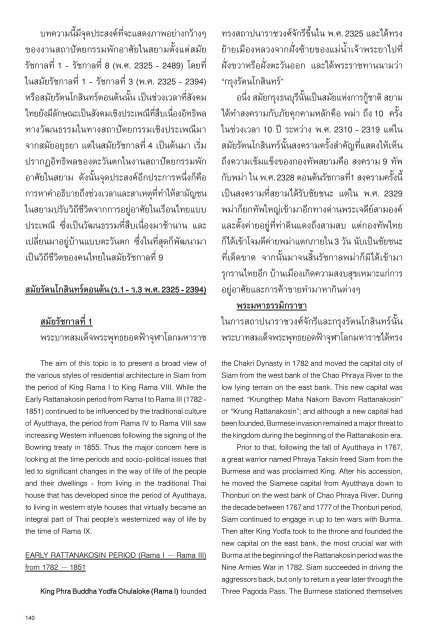บ้านเรือนถิ่นไทยในช่วงเจ็ดทศวรรษ 2489-2559
Create successful ePaper yourself
Turn your PDF publications into a flip-book with our unique Google optimized e-Paper software.
บทความนี้มีจุดประสงค์ที่จะแสดงภาพอย่างกว้างๆ<br />
ของงานสถาปัตยกรรมพักอาศัยในสยามตั้งแต่สมัย<br />
รัชกาลที่ 1 - รัชกาลที่ 8 (พ.ศ. 2325 - <strong>2489</strong>) โดยที่<br />
ในสมัยรัชกาลที่ 1 - รัชกาลที่ 3 (พ.ศ. 2325 - 2394)<br />
หรือสมัยรัตนโกสินทร์ตอนต้นนั้น เป็นช่วงเวลาที่สังคม<br />
ไทยยังมีลักษณะเป็นสังคมเชิงประเพณีที่สืบเนื่องอิทธิพล<br />
ทางวัฒนธรรมในทางสถาปัตยกรรมเชิงประเพณีมา<br />
จากสมัยอยุธยา แต่ในสมัยรัชกาลที่ 4 เป็นต้นมา เริ่ม<br />
ปรากฏอิทธิพลของตะวันตกในงานสถาปัตยกรรมพัก<br />
อาศัยในสยาม ดังนั้นจุดประสงค์อีกประการหนึ่งก็คือ<br />
การหาคำอธิบายถึงช่วงเวลาและสาเหตุที่ทำให้สามัญชน<br />
ในสยามปรับวิถีชีวิตจากการอยู่อาศัยในเรือนไทยแบบ<br />
ประเพณี ซึ่งเป็นวัฒนธรรมที่สืบเนื่องมาช้านาน และ<br />
เปลี่ยนมาอยู่บ้านแบบตะวันตก ซึ่งในที่สุดก็พัฒนามา<br />
เป็นวิถีชีวิตของคนไทยในสมัยรัชกาลที่ 9<br />
สมัยรัตนโกสินทร์ตอนต้น (ร.1 - ร.3 พ.ศ. 2325 - 2394)<br />
สมัยรัชกาลที่ 1<br />
พระบาทสมเด็จพระพุทธยอดฟ้าจุฬาโลกมหาราช<br />
The aim of this topic is to present a broad view of<br />
the various styles of residential architecture in Siam from<br />
the period of King Rama I to King Rama VIII. While the<br />
Early Rattanakosin period from Rama I to Rama III (1782 -<br />
1851) continued to be influenced by the traditional culture<br />
of Ayutthaya, the period from Rama IV to Rama VIII saw<br />
increasing Western influences following the signing of the<br />
Bowring treaty in 1855. Thus the major concern here is<br />
looking at the time periods and socio-political issues that<br />
led to significant changes in the way of life of the people<br />
and their dwellings - from living in the traditional Thai<br />
house that has developed since the period of Ayutthaya,<br />
to living in western style houses that virtually became an<br />
integral part of Thai people’s westernized way of life by<br />
the time of Rama IX.<br />
EARLY RATTANAKOSIN PERIOD (Rama I – Rama III)<br />
from 1782 – 1851<br />
King Phra Buddha Yodfa Chulaloke (Rama I) founded<br />
ทรงสถาปนาราชวงศ์จักรีขึ้นใน พ.ศ. 2325 และได้ทรง<br />
ย้ายเมืองหลวงจากฝั่งซ้ายของแม่น้ำเจ้าพระยาไปที่<br />
ฝั่งขวาหรือฝั่งตะวันออก และได้พระราชทานนามว่า<br />
“กรุงรัตนโกสินทร์”<br />
อนึ่ง สมัยกรุงธนบุรีนั้นเป็นสมัยแห่งการกู้ชาติ สยาม<br />
ได้ทำสงครามกับภัยคุกคามหลักคือ พม่า ถึง 10 ครั้ง<br />
ในช่วงเวลา 10 ปี ระหว่าง พ.ศ. 2310 - 2319 แต่ใน<br />
สมัยรัตนโกสินทร์นั้นสงครามครั้งสำคัญที่แสดงให้เห็น<br />
ถึงความเข้มแข็งของกองทัพสยามคือ สงคราม 9 ทัพ<br />
กับพม่า ใน พ.ศ. 2328 ตอนต้นรัชกาลที่1 สงครามครั้งนี้<br />
เป็นสงครามที่สยามได้รับชัยชนะ แต่ใน พ.ศ. 2329<br />
พม่าก็ยกทัพใหญ่เข้ามาอีกทางด่านพระเจดีย์สามองค์<br />
และตั้งค่ายอยู่ที่ท่าดินแดงถึงสามสบ แต่กองทัพไทย<br />
ก็ได้เข้าโจมตีค่ายพม่าแตกภายใน 3 วัน นับเป็นชัยชนะ<br />
ที่เด็ดขาด จากนั้นมาจนสิ้นรัชกาลพม่าก็มิได้เข้ามา<br />
รุกรานไทยอีก บ้านเมืองเกิดความสงบสุขเหมาะแก่การ<br />
อยู่อาศัยและการค้าขายทำมาหากินต่างๆ<br />
พระมหาธรรมิกราชา<br />
ในการสถาปนาราชวงศ์จักรีและกรุงรัตนโกสินทร์นั้น<br />
พระบาทสมเด็จพระพุทธยอดฟ้าจุฬาโลกมหาราชได้ทรง<br />
the Chakri Dynasty in 1782 and moved the capital city of<br />
Siam from the west bank of the Chao Phraya River to the<br />
low lying terrain on the east bank. This new capital was<br />
named “Krungthep Maha Nakorn Bavorn Rattanakosin”<br />
or “Krung Rattanakosin”; and although a new capital had<br />
been founded, Burmese invasion remained a major threat to<br />
the kingdom during the beginning of the Rattanakosin era.<br />
Prior to that, following the fall of Ayutthaya in 1767,<br />
a great warrior named Phraya Taksin freed Siam from the<br />
Burmese and was proclaimed King. After his accession,<br />
he moved the Siamese capital from Ayutthaya down to<br />
Thonburi on the west bank of Chao Phraya River. During<br />
the decade between 1767 and 1777 of the Thonburi period,<br />
Siam continued to engage in up to ten wars with Burma.<br />
Then after King Yodfa took to the throne and founded the<br />
new capital on the east bank, the most crucial war with<br />
Burma at the beginning of the Rattanakosin period was the<br />
Nine Armies War in 1782. Siam succeeded in driving the<br />
aggressors back, but only to return a year later through the<br />
Three Pagoda Pass. The Burmese stationed themselves<br />
140


















